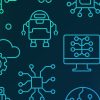Influenced by trends in enterprise architecture and new innovation, there is now more choice than ever for IT decision-makers wanting to build out a modern enterprise architecture and application portfolio.
Beyond the choices IT leaders have in terms of building or buying new applications, low-code options enable non-programmers to connect business processes and workflows quickly and easily. IT leaders are also embarking on cloud-native initiatives to drive digital innovation that builds around legacy enterprise systems of record.
According to analyst Forrester, the key business application providers have changed in the past decade. In its The buyer’s journey: Business applications report, Forrester analysts note that although its data did not assess market share, the results reveal that cloud-centric enterprise software dominated. Microsoft and Google top the list, followed by IBM, Adobe, Oracle and SAP.
Providers of collaboration tools are also high on the list, due to their widespread use. “The demand for more efficiency and productivity drove recent purchases,” say the analysts.
The most frequent drivers of business application purchases involve efficiency and effectiveness, according to Forrester, which it says is consistent with other trends observed in a time of shaky economic conditions and global resource constraints.
However, it also reports that the buying patterns of technology decision-makers differ slightly to those of business decision-makers, with those with a tech perspective seeking to “create new products or services” and “better comply with regulations and requirements” more often than their business peers.
While the Forrester analysts note that both technology and business decision-makers were seeking to “improve efficiency” and “improve productivity and effectiveness”, those focused on business were more likely to select these key drivers.
“These patterns align with typical buying behaviour: IT tends to be more concerned with policies and enterprise fit, while business stakeholders focus primarily on doing their job effectively and achieving business results,” the report says.
Forrester says technology decision-makers tasked with a business application purchase most often look for technology expertise from their winning business software provider. Next in their selection criteria are a competitive price, a strong reputation and the ability of the application to meet their business needs.
Looking at how enterprise software is purchased, the analyst firm reports that the primary method most frequently cited for the initial purchase is a contract/purchase order with an enterprise account rep, at 36% – this is also the leading transaction method for renewals or footprint expansion. Digital buying accounts for about a quarter of initial purchases, with 23% made via the supplier’s website and another 3% taking place on an external marketplace or via a third-party app store.
Investing in the data-driven enterprise
A big initiative driving enterprise software investments is the need for businesses to get more value out of the data they collect.
In October 2022, 451 Research, which is part of S&P Global Market Intelligence, investigated data-driven organisations. It found that a majority continue to base most of their strategic decisions on data – and that data is growing in importance over time.
“Prior to the pandemic, it was common for enterprise survey respondents to rank lowering costs and increasing sales as top expected benefits of becoming more data driven – tangible metrics closely tied to quarterly performance. Today’s top perceived benefits are more focused on long-term business resiliency and adaptability,” senior research analyst Paige Bartley wrote in a blog post.
“The top three responses now include improving/automating business processes (41%), increasing agility of decision-making (40%), and enhancing customer service and engagement (39%).”
Today, artificial intelligence (AI) is a logical extension of a data-driven strategy.
The AI revolution
In August 2023, Gartner put generative AI (GenAI) at the top of its hype cycle report on emerging technology. The analyst firm has also identified demand for AI to help accelerate and scale talent. It describes this as the augmented-connected workforce (ACWF).
The ACWF uses intelligent applications and workforce analytics to provide everyday context and guidance to support the workforce’s experience, well-being and ability to develop its own skills. At the same time, the ACWF drives business results and positive impact for key stakeholders.
Through 2027, Gartner forecasts that 25% of CIOs will use augmented-connected workforce initiatives to reduce time to competency by 50% for key roles.
The industry has begun ramping up initiatives to embed AI in its products. Earlier this year, for instance, Microsoft unveiled Copilot, which it describes as “your copilot for work”. The technology is based on combining large language models (LLMs) with internal corporate data in the Microsoft Graph and Microsoft 365 apps to boost office productivity.
Google’s rival AI capability is called Duet, an AI for Google Workspace, which embeds generative AI across the company’s office productivity and collaboration toolset.
At Oracle CloudWorld 2023, chief technology officer and founder Larry Ellison used his keynote to discuss the AI opportunity. The company is stepping up its provision of artificial intelligence in the Oracle Fusion suite of cloud-based applications, claiming “the new capabilities detect and connect relevant account records in Oracle Fusion Cloud ERP to provide sellers with actionable insights”.
At the conference, it also announced the addition of AI to Oracle Fusion Cloud Customer Experience (CX) to help marketers, sellers and service agents grow revenue. Oracle claimed these latest AI capabilities “liberate marketers, sellers and service agents from time-consuming and manual tasks by unlocking relevant content, recommendations and insights with automation and conversational interfaces”.
Meanwhile, SAP has unveiled an AI assistant called Joule, which will be embedded across SAP’s cloud product portfolio, including SuccessFactors, later this year, and the public edition of S/4Hana Cloud in 2024. SAP Customer Experience, Ariba and SAP Business Technology Platform (BTP) will follow, according to the company.
The Joule AI assistant is designed to provide customers with contextualised information and assistance when performing tasks in SAP applications.
During its third-quarter earnings call, SAP CEO Christian Klein revealed there would be a 30% premium for customers wishing to use the AI and sustainability “bolt-ons” to Rise. According to the transcript of the call, posted on Seeking Alpha, he said: “We are not offering generative AI, sustainability, capabilities and differentiating capabilities in our line of business products on-prem.”
Salesforce, too, has been working on boosting AI capabilities in its software-as-a-service (SaaS) platform. In September 2023, it unveiled Einstein 1, an AI platform built with Salesforce’s metadata framework at its core, developed to enable customers to create and train AI-powered applications.
Constellation Research analyst Doug Henschen told Search Data Management, a sister title of Computer Weekly, that competitive forces are driving Salesforce to invest more deeply in data analytics.
Meanwhile, at its annual conference, human resources SaaS provider Workday brought forward a selection of AI-related enhancements. The company announced several new features within Workday Human Capital Management (HCM) that simplify and elevate the manager experience by empowering them with the tools the company claims they need to lead efficiently and effectively.
These new capabilities aim to provide managers with timely insights and recommended actions around things like team time off, important dates, employee skills, sentiment and goals. AI is a big focus of the update.
“Managers play such a pivotal role in the growth and development of their teams but face increasing pressure to improve productivity and performance while navigating evolving workplace policies,” says David Somers, group general manager for the office of the chief human resource officer product at Workday.
“Workday is the single source of truth for people data, enabling us to surface relevant team information to managers when they need it most, helping them be more impactful. Workday AI is making it easier for managers to succeed in their most important role: people leadership.”
Workday also announced the availability of Manager Insights Hub, which uses AI and machine learning (ML) to surface personalised recommendations that, according to Workday, make it easier for managers to proactively identify the best opportunities for their employees based on skills interests.
The upgrade conundrum
Many big companies traditionally begin an enterprise software refresh by assessing the business problems they want to solve, then buy off-the-shelf, shrink-wrapped software and hire some consultants to integrate the enterprise system.
Four years ago, former Amazon, Google and Microsoft tech leader Suresh Kumar joined Walmart as its global CTO. Under his leadership, the retailer has transitioned to building software in-house rather than taking the route of sending out a request for proposals (RFP) and bringing in software providers.
According to David Glick, senior vice-president for enterprise services at Walmart, many off-the-shelf products are unable to meet the scale the business requires. “We need to be able to customise exactly what we need, and it needs to be resilient and stay up 100% of the time,” he says.
Glick says Walmart has spent a lot of money and engineer time on moving off of the mainframe and into the cloud, or into its own on-premise cloud. “We have a platform called the Walmart Cloud Native platform, which we use to abstract away which cloud we’re on, or if we’re on a mainframe, or anything else, so that we can deploy software quickly,” he says. “That’s allowed us to move much more quickly with advancing our technology.”
While there is a drive to sweat IT assets, CIOs need to balance enhancing existing software with buying a new enterprise system. However, building on top of an older enterprise IT system or enhancing a legacy application may only offer a partial return on investment.
Liz Herbert, vice-president and principal analyst at Forrester, believes the conundrum in enterprise software is that while small enhancements can indeed help to extend the life of older enterprise software, this also delays the benefits a modern enterprise application offers.
“A lot of times, older enterprise software that has already been paid off can certainly be very cheap to support, but it comes with very serious challenges. Some of the older technologies are not designed for the best performance and security,” she warns.
There are also advances in technology that newer enterprise systems are able to integrate, such as AI and automation functionality, that drive efficiency gains.
There will always be a debate over whether to build or buy, and IT leaders are likely to continue to evolve their own cloud-native architectures as their organisations expand their digitisation.
Looking at the overall enterprise software market, what is clear is that the major software providers are focused on offering greater insights from data in the current crop of commercial off-the-shelf enterprise software. This is quickly evolving with embedded AI to drive efficiency and improve analytics.






